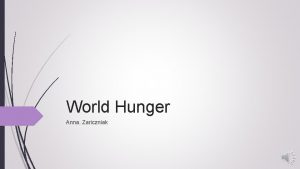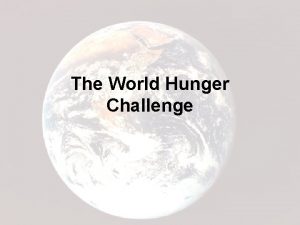WORLD HUNGER The Facts WORLD HUNGER FACTS More









- Slides: 9

WORLD HUNGER The Facts

WORLD HUNGER FACTS More than 840 million people in the world are malnourished— 799 million of them are from the developing world. More than 153 million of them are under the age of 5. 6 million children under the age of 5 die every year as a result of hunger. Of the 7 billion people in today's world, 1. 2 billion live on less than $1 per day. The proportion of people living on less than $1 a day has fallen from 29 percent to 23 percent in the past 10 years, although that masks significant regional differences. – East Asia has seen a drop from 28 percent to 14 percent. – South Asia has seen a drop from 44 percent to 37 percent. – Africa has seen a drop from 48 percent to only 47 percent.

World Hunger Facts The amount of money that the richest 1 percent of the world's population make each year equals what the poorest 57 percent make. The richest 5 percent of the world's population have incomes 114 times that of the poorest 5 percent. Malnutrition can severely affect a child's intellectual development. Children who have stunted growth due to malnutrition score significantly lower on math and language achievement tests than do well-nourished children. Virtually every country in the world has the potential of growing sufficient food on a sustainable basis. The Food and Agriculture Organization of the United Nations has set the minimum requirement for caloric intake person per day at 2, 350. Worldwide, there are 2, 805 calories available person per day. Fifty-four countries fall below that requirement; they do not produce enough food to feed their populations, nor can they afford to import the necessary commodities to make up the gap. Most of these countries are in sub-Saharan Africa.

World Hunger Vocabulary Why Food: The Basics Agricultural Development Food Production: Factors Reasons for Food Crisis

FAMINE World Hunger: Terms A temporary failure of food production or distribution systems in a particular region that leads to increased mortality due to starvation and diseases that result from lack of food. Natural Causes: drought, crop disease Human Causes: civil war Example: 1984 Famine in Ethiopia “Up to five children die every day” Read more about the Ethiopian Famine Is it going to happen again?

Starvation World Hunger: Terms An extreme form of hunger in which people suffer from a total lack of energy and essential minerals. The body wastes away as tissue is consumed to provide protein and energy. Malnutrition • a condition which damage to health is caused by a diet that includes either too much or too little of one or more essential nutrients over an extended period. - This could include obesity and high blood pressure as these are caused by excesses in diet - International development usually focuses on lack of nutrients or poor food quality. This type of malnutrition is called undernutrition.

Provides The Importance of Food materials and nutrients for cell growth. It provides us with the energy we need for growth, physical activity and the basic body functions (breathing, thinking, temperature control, blood circulation and digestion, metabolism). Food also supplies us with the materials to build and maintain the body and to promote resistance to disease. Food gives the body energy – Kilojoules (KJ) or Calories (Note: if all of the Calories that we eat are not burned up for energy use the body stores these calories as Fat). An average person needs about 2200 kcal per day. A Canadian gets on average 2900 KJ per day. What pattern do you see on the following map?

Food and Agriculture Organization - The UN

Food: Nutrients These different functions are made possible by the nutrients contained in food. The types of nutrients in food are carbohydrates, proteins, fats, vitamins, minerals and water. All foods contain one or more of these nutrients in varying amounts. Each type of nutrient serves particular functions. This is why diversity in our diets is important for good health. We need all of the nutrients, provided by a variety of foods, for all of our body processes. Although one may eat enough kilo-calories of food, one can still suffer from malnutrition, if there is a lack of essential nutrients.
 More more more i want more more more more we praise you
More more more i want more more more more we praise you More more more i want more more more more we praise you
More more more i want more more more more we praise you 5 apples in a basket riddle
5 apples in a basket riddle The more you study the more you learn
The more you study the more you learn Aspire not to
Aspire not to Newton's 1 law
Newton's 1 law Knowing more remembering more
Knowing more remembering more More love to thee o lord
More love to thee o lord More choices more chances
More choices more chances Human history becomes more and more a race
Human history becomes more and more a race
















